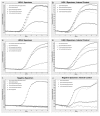Real-Time PCR for detection of herpes simplex virus without nucleic acid extraction
- PMID: 16796763
- PMCID: PMC1533833
- DOI: 10.1186/1471-2334-6-104
Real-Time PCR for detection of herpes simplex virus without nucleic acid extraction
Abstract
Background: The speed and sensitivity of real-time polymerase chain reaction (PCR) have made it a popular method for the detection of microbiological agents in both research and clinical specimens. For the detection and genotyping of herpes simplex virus (HSV) in clinical specimens, real-time PCR has proven to be faster, more sensitive and safer than earlier methods which included isolation of the virus in cell culture followed by immunofluorescence microscopy. While PCR-based assays for HSV detection posses clear advantages over these earlier techniques, certain aspects of the PCR method remain onerous. The process of extraction and purification of nucleic acid from clinical specimens prior to PCR is particularly cumbersome. Nucleic acid extraction is expensive, time-consuming and provides a step whereby specimens can become contaminated prior to their analysis. Herein, we investigate the necessity of nucleic acid extraction from swab-based clinical specimens for HSV detection by real-time PCR. We find that nucleic acid extraction is unnecessary for specific and sensitive detection of HSV in clinical specimens using real-time PCR.
Methods: Prospective (n = 36) and retrospective (n = 21) clinical specimens from various anatomical sites were analyzed for the presence of herpes simplex virus 1 or 2 by real-time PCR using the RealArt HSV 1/2 LC PCR Kit. Specimens were analyzed by PCR both before and following automated nucleic acid extraction. PCR using extracted and unextracted specimens was also compared to cell culture as a means of detecting HSV.
Results: Detection of HSV 1/2 DNA in clinical specimens by real-time PCR did not require that the specimen be subjected to nucleic acid extraction/purification prior to analysis. Each specimen that was detectable by real-time PCR when analyzed in the extracted form was also detectable when analyzed in the unextracted form using the methods herein. The limit of detection of HSV-1 and HSV-2 particles when analyzed in the unextracted form was found to be approximately 17 and 32 virus particles respectively, compared to a sensitivity of 10 copies, for analysis of purified DNA. Omission of the nucleic acid extraction step shortened both the assay time and cost.
Conclusion: Omission of the nucleic acid extraction step prior to real-time PCR for detection of herpes simplex virus resulted in a more rapid and cost-effective assay, with little impact upon the sensitivity of detection.
Figures

Similar articles
-
Routine use of a highly automated and internally controlled real-time PCR assay for the diagnosis of herpes simplex and varicella-zoster virus infections.J Clin Virol. 2004 May;30(1):39-44. doi: 10.1016/j.jcv.2003.08.006. J Clin Virol. 2004. PMID: 15072752
-
Use of two real-time polymerase chain reactions (PCRs) to detect herpes simplex type 1 and 2-DNA after automated extraction of nucleic acid.J Med Virol. 2004 Nov;74(3):459-62. doi: 10.1002/jmv.20198. J Med Virol. 2004. PMID: 15368516
-
Detection and differentiation of herpes simplex virus types 1 and 2 by a duplex LightCycler PCR that incorporates an internal control PCR reaction.J Clin Virol. 2004 May;30(1):32-8. doi: 10.1016/j.jcv.2003.08.003. J Clin Virol. 2004. PMID: 15072751
-
Diagnosis of herpes simplex virus infections.J Clin Virol. 2001 Jun;21(3):255-9. doi: 10.1016/s1386-6532(00)00168-2. J Clin Virol. 2001. PMID: 11397662 Review. No abstract available.
-
Diagnostic Utility of Preserved Dried Umbilical Cord Polymerase Chain Reaction in Intrauterine Herpes Simplex Virus Infection: A Case Report and Literature Review.Neonatology. 2025;122(1):27-31. doi: 10.1159/000540506. Epub 2024 Aug 13. Neonatology. 2025. PMID: 39137732 Review.
Cited by
-
Fluorescence resonance energy transfer-based real-time polymerase chain reaction method without DNA extraction for the genotyping of F5, F2, F12, MTHFR, and HFE.J Blood Med. 2014 Jun 25;5:99-106. doi: 10.2147/JBM.S64976. eCollection 2014. J Blood Med. 2014. PMID: 25028568 Free PMC article.
-
Advances in Directly Amplifying Nucleic Acids from Complex Samples.Biosensors (Basel). 2019 Sep 30;9(4):117. doi: 10.3390/bios9040117. Biosensors (Basel). 2019. PMID: 31574959 Free PMC article. Review.
-
Quadruplex real-time PCR for rapid detection of human alphaherpesviruses.Med Microbiol Immunol. 2019 Apr;208(2):197-204. doi: 10.1007/s00430-019-00580-2. Epub 2019 Jan 24. Med Microbiol Immunol. 2019. PMID: 30680459
-
Diagnosis of Herpes Simplex Virus: Laboratory and Point-of-Care Techniques.Infect Dis Rep. 2021 Jun 2;13(2):518-539. doi: 10.3390/idr13020049. Infect Dis Rep. 2021. PMID: 34199547 Free PMC article. Review.
-
Development and Preliminary Application of a Droplet Digital PCR Assay for Quantifying the Oncolytic Herpes Simplex Virus Type 1 in the Clinical-Grade Production.Viruses. 2023 Jan 7;15(1):178. doi: 10.3390/v15010178. Viruses. 2023. PMID: 36680218 Free PMC article.
References
-
- Filén F, Strand A, Allard A, Blomberg J, Herrmann B. Duplex Real-Time Polymerase Chain Reaction Assay for Detection and Quantification of Herpes Simplex Virus Type 1 and Herpes Simplex Virus Type 2 in Genital and Cutaneous Lesions. Sexually Transmitted Diseases. 2004;6:331–336. doi: 10.1097/00007435-200406000-00002. - DOI - PubMed
-
- Schuurman T, van Breda A, de Boer R, Kooistra-Smid M, Beld M, Savelkoul P, Boom R. Reduced PCR sensitivity Due to Impaired DNA Recovery with the MagNA Pure LC Total Nucleic Acid Isolation Kit. Journal of Clinical Microbiology. 2005;43:4616–4622. doi: 10.1128/JCM.43.9.4616-4622.2005. - DOI - PMC - PubMed
MeSH terms
Substances
LinkOut - more resources
Full Text Sources
Other Literature Sources
Molecular Biology Databases

